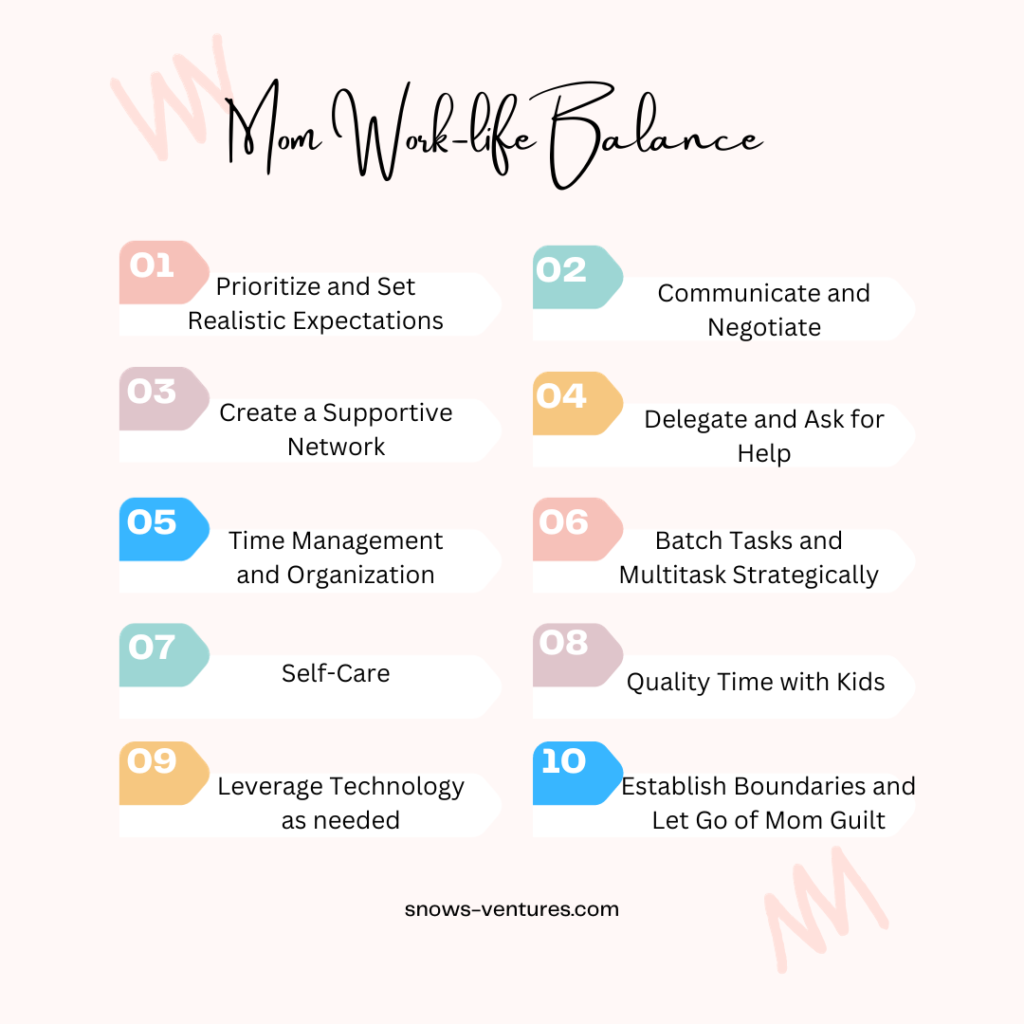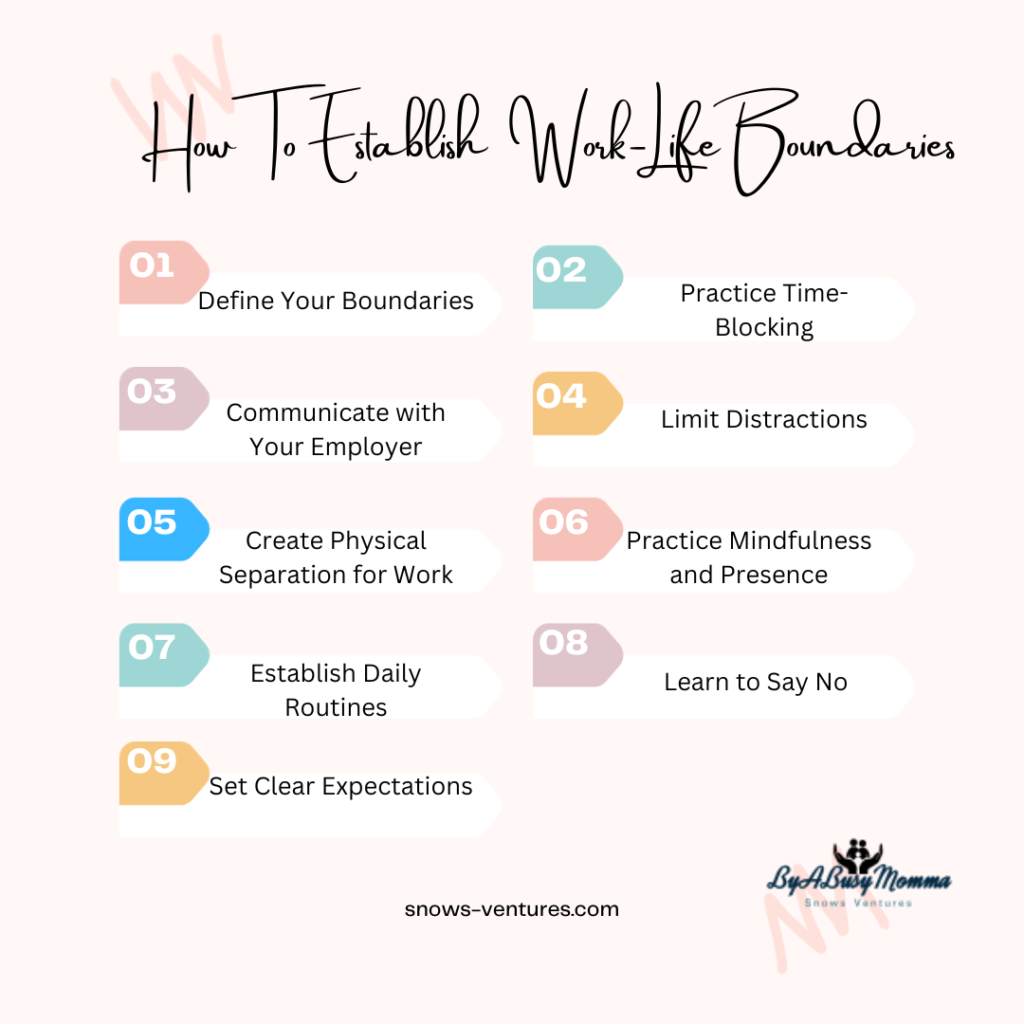As a working mom, there can be times when you feel super overwhelmed and frustrated because you always have so much on your schedule during the day and night. It can be challenging and complex to be available for your family while you try to keep the house in order and excel at work. I have been there myself, and some days, I still go back to that feeling of chaos and being out of control, but I now have tools that help me manage and balance these responsibilities more healthily and repetitively. This does not always mean perfection, but having an outline or a blueprint of what you should do helps keep you on track. In other words, these tips are blueprints for a more balanced work and mom life experience.

Balancing work and family as a working mom can be challenging, but finding a balance that works for you is possible with some strategies and support. One of the essential things to consider is knowing how to manage stress and avoid burnout as a working mom. Managing stress and having a healthy work-life balance is crucial for effectively supporting your well-being and balancing work and family responsibilities.
Check out the following tools on Amazon for work-life balance and help with busy mom life:
1.Planner

Here are some tips to help you navigate the juggling act of mom and work life, as well as some strategies to help you manage stress and prevent burnout as you juggle your many responsibilities:
Prioritize and Set Realistic Expectations:
- Recognize that you cannot do everything perfectly.
- Set realistic expectations for yourself and prioritize your tasks and responsibilities.
- Figure out what is most important to you and focus your energy on those areas.
- Find your top priorities at work and home.
- Focus on tasks that matter and delegate or outsource tasks others can handle.
Whether hiring help for household chores or involving your partner and children in age-appropriate tasks, sharing responsibilities lightens your load. Adjust your expectations and let go of perfectionism. Understand that you cannot do everything flawlessly and that it’s okay to prioritize and make choices that align with your values. Set realistic expectations for yourself regarding work and family and focus on progress rather than perfection.
Communicate and Negotiate:
- Openly communicate with your employer about your needs as a working mother.
- Explore flexible work hours, remote work, or part-time arrangements that can help you better balance work and family responsibilities.
- Negotiate for a schedule that suits your needs whenever possible.
- Talk to your employer about options to better accommodate your family’s needs.
Create a Supportive Network:
- Build a support system of family, friends, and other working moms who can offer help, advice, and understanding. You can also join our mom support group on our Instagram page @byabusymomma.
- Share responsibilities and consider options like childcare, parenting arrangements, or support from extended family to lighten the load.
- Seek support from trusted caregivers or extended family.
Delegate and Ask for Help:
- Learn to delegate work and home tasks. Ask for help when needed.
- Accept help from your partner, family, or trusted caregivers to share the workload.
- Delegate household chores and involve children in age-appropriate tasks to teach them responsibility and lighten their load.
- Recognize that you do not have to shoulder all the responsibilities alone.
- Involve your partner, children, or trusted caregivers in sharing the workload.
Accepting help lightens your burden and creates a support system. Don’t hesitate to seek support from your partner, family, friends, or support groups for working moms. Share your feelings, concerns, and challenges with them. They can provide emotional support, practical assistance, and valuable advice. Remember, you don’t have to do it all alone.
Time Management and Organization: Efficient time management is crucial. Plan and prioritize your time, both at work and at home. Use calendars, to-do lists, and productivity apps to stay organized and manage your tasks effectively. Minimize distractions and focus on one task at a time. Use effective time management techniques to maximize your productivity. Prioritize your tasks, break them into smaller, manageable chunks, and set realistic deadlines. Use to-do lists, calendars, and productivity apps to stay organized and on track. Effective time management and organization are vital to reducing stress. Plan and prioritize your tasks, break them into manageable chunks, and create a schedule. Use calendars, to-do lists, and productivity apps to stay organized and on top of your responsibilities.
Batch Tasks and Multitask Strategically: Group and tackle similar tasks in batches. For example, set aside specific times for email responses, phone calls, or household errands. Multitask strategically by combining activities that can be done simultaneously, such as listening to audiobooks or podcasts while doing household chores.
Self-Care: Take care of yourself to support your physical and mental well-being. Prioritize self-care activities such as exercise, relaxation, hobbies, and spending time with family and friends. Remember that caring for yourself is not selfish but necessary for maintaining a healthy balance. Take care of your physical and mental well-being by engaging in activities that recharge and rejuvenate you. Make self-care a non-negotiable part of your routine. Prioritize activities that nourish and renew you, such as exercise, relaxation techniques, hobbies, and spending time with loved ones. Taking care of yourself physically, mentally, and emotionally equips you to handle stress better. Regularly check in with yourself and monitor your well-being. Recognize signs of burnout, such as chronic fatigue, irritability, decreased motivation, or changes in sleep patterns. If burnout is looming, adjust your workload, seek professional support, or reassess your priorities.
Quality Time with Children:
- Make the most of your time with your children by being present and engaged.
- Create unique routines or rituals, such as family meals or dedicated playtime, to establish meaningful connections.
- Focus on quality over quantity and maximize your time together.
Capitalize on Technology:
- Leverage technology to streamline your work and home life.
- Use productivity apps and tools for task management, online calendars for scheduling, and collaboration platforms for efficient communication with colleagues.
- Use smart home devices or apps to automate tasks and save time at home.
Unplug and Disconnect: Take regular breaks from technology and disconnect from work-related devices and notifications. Create tech-free zones or designated times when you are fully present with your family and not distracted by work. This helps you recharge, be more present, and maintain a healthy work-life integration.
Embrace Imperfection:
- Accept that there will be times when things don’t go as planned or you feel pulled in different directions.
- Embrace imperfection and practice self-compassion.
- Remember that you are doing your best, and making mistakes or asking for support is okay.
Establish Boundaries:
- Set clear boundaries between work and family time.
- Designate specific hours for work and create boundaries that allow you to be fully present with your family during your non-work hours.
- Avoid bringing work-related stress or tasks into your family time.
- Establish and communicate precise work hours to your employer, colleagues, and family.
- Set boundaries by turning off work-related notifications outside of those hours.
This helps create a clear separation between work and family time. Set clear boundaries between work and personal life. Define specific times for work and family, and communicate these boundaries to your employer, colleagues, and family members. Respect these boundaries and avoid overextending yourself by taking on additional tasks or working during designated personal time.
Let Go of Mom Guilt: Mom guilt is common, but try to ignore it. Please recognize that you are doing your best and that it’s normal to feel conflicted. Trust your decisions and the love and care you provide for your children. Accept that you can’t do everything perfectly and that feeling guilt or self-doubt is usual. Let go of perfectionism and embrace the idea that good enough is often sufficient. Practice self-compassion and remind yourself that you are doing your best for your career and family.

Establishing precise work and family time boundaries is essential for a healthy work-life balance. Here are some strategies to help you set and maintain those boundaries:
Define Your Boundaries: Start by determining your ideal work and family boundaries. Consider factors such as the number of working hours per day, specific days or times off-limits for work, and the activities or events important to you and your family. Clearly define what constitutes work time and what constitutes family time.
Communicate with Your Employer:
- Openly communicate your boundaries and expectations with your employer.
- Discuss your availability and preferred working hours and negotiate flexible arrangements.
- Seek their understanding and support in maintaining a healthy work-life balance.
Create Physical Separation:
- If you have the option, create a physical separation between your workspace and family space.
- Designate a specific area in your home as your office or workspace.
- When you’re in that area, make it clear to your family members that you are “at work” and should only be disturbed for urgent matters.
Establish Daily Routines: Establishing daily routines can help reinforce boundaries. Set specific start and end times for your workday, and stick to them as much as possible. Create consistent routines for transitioning between work and family time, such as walking, changing clothes, or engaging in a brief relaxation practice.
Set Clear Expectations: Communicate your boundaries and expectations to your family members. Tell them when you need uninterrupted work time and when you’ll be available for family activities. Setting clear expectations helps everyone understand and respect your designated work and family hours.
Practice time-blocking: Use time-blocking techniques to schedule your work and family activities. Allocate specific time blocks for work-related tasks, family time, self-care, and other important commitments. By planning your time, you can allocate sufficient hours for work and family, reducing the likelihood of overlap or neglecting either area.
Limit Distractions: Minimize distractions during your designated work hours. Turn off notifications on your phone or computer, close unnecessary tabs or applications, and create a focused work environment. By staying focused on work tasks, you can be more efficient and complete your work within the allocated time, allowing for more dedicated family time.
Practice Mindfulness and Presence: When spending time with your family, be fully present and engaged. Put away work-related devices and avoid checking emails or taking work calls. Being fully present in the moment can strengthen your connections with your loved ones and enjoy quality family time. Incorporate stress management techniques into your daily routine. This can include exercises, mindfulness, journaling, or engaging in activities that help you relax and unwind. Find what works best for you and make it a regular day. Cultivate mindfulness by staying present and paying attention to your thoughts and emotions without judgment. Incorporate gratitude practices into your daily life, focusing on the positive aspects of your work and family. This mindset shift can reduce stress and increase resilience.
Learn to Say No: Be selective about additional work commitments or responsibilities that may encroach on your family time. Learn to say no when necessary and set boundaries with colleagues or clients who may try to infringe upon your non-work hours.

Remember, establishing boundaries requires consistency, communication, and self-discipline. It may take time to develop new habits and for others to adjust to your boundaries. However, with persistence and clear communication, you can create a healthier separation between work and family time. Finding a work-life balance is an ongoing process. Experiment with different strategies, be flexible, and adjust as needed to suit your family’s and career’s changing needs. Every family’s situation is unique; finding the right balance takes time and experimentation. Be patient with yourself, adjust as needed, and be open to adapting your strategies along the way. Be kind to yourself, be patient, and prioritize your well-being. By taking care of yourself, you will be better equipped to handle the demands of work and family and support a healthy balance.
